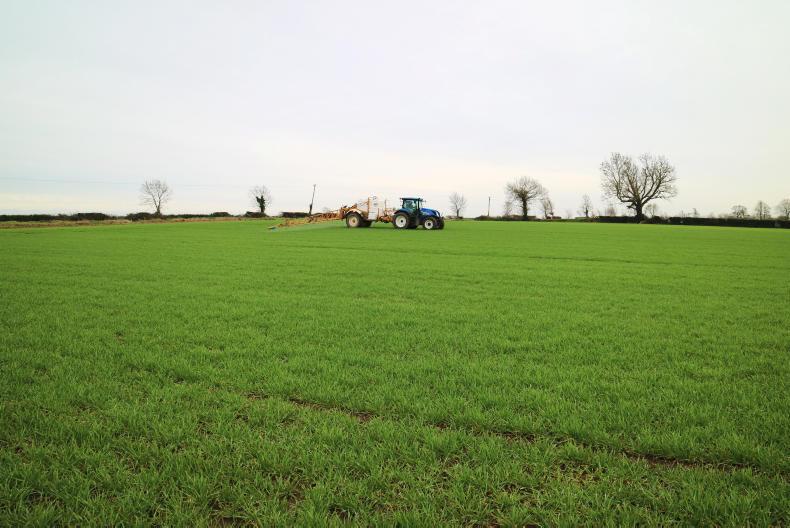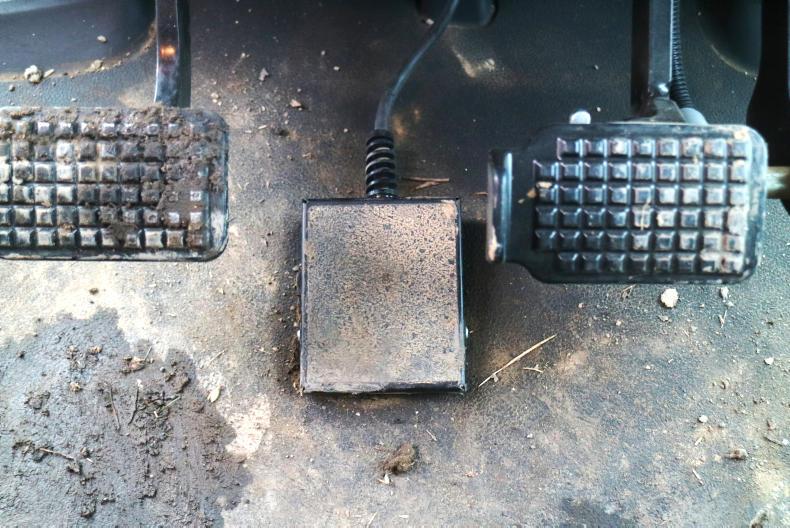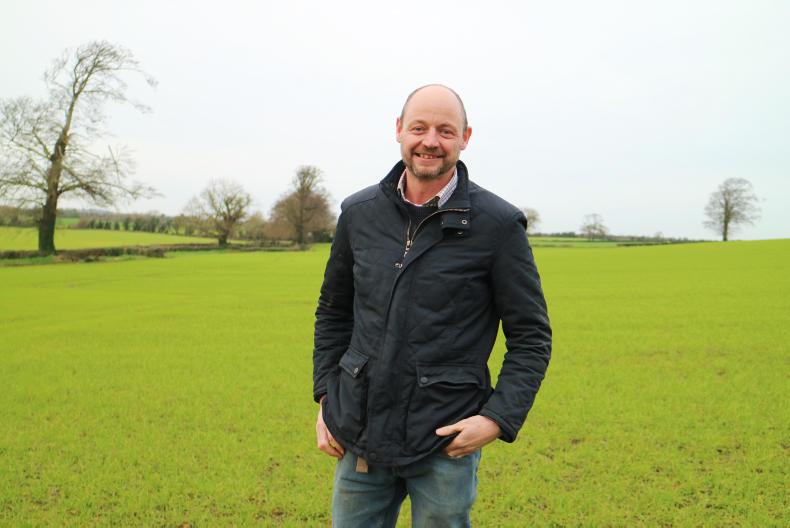With the current BETTER farm crops programme set to draw to a close at the end of 2019, we caught up with each of the participants. Over the next number of weeks we’ll be bringing you reports from all three farmers involved, focusing on their experiences.

The display unit is connected to a assisted steering system and pedal.
This is the second instalment of the BETTER farm crops programme and the main focus of this tranche was the use of precision agriculture and how new technologies can complement existing farming practice to improve profitability.
This week we profile Derek Keeling, who farms around 390ha of owned and rented land in Oldtown, Co Dublin.
Operating a plough-based system, Derek used to grow winter wheat on a continuous basis. However, he now grows both winter wheat and barley.
He also regularly swaps land with a local potato grower for rotational purposes and grows a small amount of spring barley, based on land availability.

The FM 750 display unit on his New Holland T7 230 tractor.
Upon being asked to enter the programme in 2017, Derek thought that more regular interaction with Teagasc advisers and researchers on an ongoing basis could prove beneficial to his farm in a number of ways.
As a BETTER farmer he expected that he could gain a more detailed understanding of soil test results, learn how to use organic manures more efficiently and better plan fertiliser requirements. He also aimed to learn how to manage field variability and gain a greater understanding of GPS technology.
A history of precision farming
When asked what precision farming means, you would be forgiven for thinking GPS, auto steer, section control and other forms of technology. However, Derek takes a different approach to precision farming.
“We’ve always been doing precision farming here, just without any of the tools,” he explains.
Precision for Derek means looking at and monitoring every crop closely, making decisions based on what that crop requires and keeping detailed records on every aspect of crop production. For example, he has weighed every load which comes off the fields at harvest for the past 15 years and maintains records of each. All records are kept in his IGAS book.
The farm also has soil sample results dating back to 1975.

Derek was applying an aphicide at the time of our visit.
Until 2017 he didn’t use GPS enabled equipment in a meaningful manner, as he was happy with his level of precision using his existing machinery. For example, control of his spreader and sprayer are all manual.
“We were still getting a good level of precision through just watching what we were doing when driving though the field.”
Derek runs an efficient farming operation and employs just one full-time staff member, but hires in local contractors during peak labour demand.
During harvest he sells all of his straw on the ledge to local contractors who bale and gather it.
This eliminates the need for dedicated labour and machinery for gathering straw.
Field assessments
The real purpose of talking to the three BETTER crop farmers was to understand their experience of being a part of the programme. For Derek, it’s been a good one.
The focus of attention by Teagasc was largely concentrated in two fields, he explains. In year one of the programme, researchers and specialists focused on understating the variability in those fields.
They took soil samples, assessed soil type and structure, conducted plant and worm counts and examined historical field data.

Derek was applying an aphicide at the time of our visit.
“They worked out the difference in potential yields between the good and bad spots.
The whole idea was how we could make the poorer parts of the field as good as the good parts,” Derek explains. This, he says was one of the question posed.
Through discussions with Teagasc, various strategies were devised on how to address the variations in the fields, such as through better nutrient planning, using organic manures and liming.
In year two of the programme, they looked intensely into the use of organic manures and nutrient management planning on the farm.
Up until that point Derek had based his fertiliser requirements on soil type and off-takes, but this led to lower-than-optimum soil P levels.

Derek Keelings winter crops are looking lush and green but mildew and aphids are present.
He then adjusted his fertiliser programme based on these results and subsequent conversations with Teagasc.
Another interesting exercise that was done in year two was measuring the width of his tramlines.
This was done to test how accurate his planting was when using scribes on his seed drill, he explains. As it turns out, they were quite accurate.
Organic manures
Derek first started using spent mushroom compost 10 years ago on 100 acres of worn ground. When he saw positive results he continued to use it at a rate of 6t/ac. In 2018 alone he spread 2,600t.
From looking at the VESS (Visual Soil Examination and Evaluation) test and through conversations with Mark Plunkett, Teagasc’s soil and plant nutrition specialist, Derek decided to try pig slurry last year when an amount became available to him.

Derek Keelings winter crops are looking lush and green but mildew and aphids are present.
Teagasc tested the pig slurry he was using so he knew exactly what the available nutrients were. This allowed for more accurate nutrient planning.
“When we first got pig manure it looked watery, but when we got it tested it was quite good,” he remarks.
New technology
Derek first invested in GPS guidance technology in spring 2013, but it went relatively unused since.
However, last year with the investment in a new New Holland T7 230 tractor, an auto steer kit was offered as part of the deal.
Through conversations with research officer Dermot Forrestal, and through noticing increased driver fatigue when working long hours, the decision to install the kit was an easy one, he says.
Using the New Holland FM 750 display unit, which connects to an assisted steering system and pedal, he achieves steering accuracy of 2cm using the RTK network.
He now uses the auto steer for sowing, cultivating and hopes to be able to install it in his combine harvester.
There is an annual subscription of €900 for the year, which he thinks is worth it.

The display unit is connected to a assisted steering system and pedal.
“It’s made a huge difference, especially when driving at night time. There were fields last autumn which you couldn’t sow at night because you wouldn’t see the scribes, but with auto steer you just hit the button. I wouldn’t go back,” Derek explains.
In addition to this, Derek has made an application through TAMS for a new GPS enabled fertiliser spreader.
“I’m hoping the auto shut-off will help stop lodging in the corners and headlands,” he explains.
While he doesn’t have ambitions of upgrading the sprayer in the short term, Derek remarked that his next purchase will be a sprayer equipped with GPS section control.
Programme experiences
The entire experience of being involved with the programme has been a positive one, explains Derek.
While he learned a lot from the various activities carried out on the farm throughout the programme, the real value to him has been the conversations with Teagasc.
“It was a joy having them out on the farm, I could talk to them about different things to see what they thought,” Derek explains.
Hosting two BETTER farm walks on his farm and having to speak to the crowds was also a new experience for him.
“I would recommend joining the programme, you’ll always learn something from entering a programme like this. Teagasc was a pleasure to deal with.”
Read more
Precision applications of inputs on BETTER Farms
BETTER farms equally hit by poor field conditions
With the current BETTER farm crops programme set to draw to a close at the end of 2019, we caught up with each of the participants. Over the next number of weeks we’ll be bringing you reports from all three farmers involved, focusing on their experiences.

The display unit is connected to a assisted steering system and pedal.
This is the second instalment of the BETTER farm crops programme and the main focus of this tranche was the use of precision agriculture and how new technologies can complement existing farming practice to improve profitability.
This week we profile Derek Keeling, who farms around 390ha of owned and rented land in Oldtown, Co Dublin.
Operating a plough-based system, Derek used to grow winter wheat on a continuous basis. However, he now grows both winter wheat and barley.
He also regularly swaps land with a local potato grower for rotational purposes and grows a small amount of spring barley, based on land availability.

The FM 750 display unit on his New Holland T7 230 tractor.
Upon being asked to enter the programme in 2017, Derek thought that more regular interaction with Teagasc advisers and researchers on an ongoing basis could prove beneficial to his farm in a number of ways.
As a BETTER farmer he expected that he could gain a more detailed understanding of soil test results, learn how to use organic manures more efficiently and better plan fertiliser requirements. He also aimed to learn how to manage field variability and gain a greater understanding of GPS technology.
A history of precision farming
When asked what precision farming means, you would be forgiven for thinking GPS, auto steer, section control and other forms of technology. However, Derek takes a different approach to precision farming.
“We’ve always been doing precision farming here, just without any of the tools,” he explains.
Precision for Derek means looking at and monitoring every crop closely, making decisions based on what that crop requires and keeping detailed records on every aspect of crop production. For example, he has weighed every load which comes off the fields at harvest for the past 15 years and maintains records of each. All records are kept in his IGAS book.
The farm also has soil sample results dating back to 1975.

Derek was applying an aphicide at the time of our visit.
Until 2017 he didn’t use GPS enabled equipment in a meaningful manner, as he was happy with his level of precision using his existing machinery. For example, control of his spreader and sprayer are all manual.
“We were still getting a good level of precision through just watching what we were doing when driving though the field.”
Derek runs an efficient farming operation and employs just one full-time staff member, but hires in local contractors during peak labour demand.
During harvest he sells all of his straw on the ledge to local contractors who bale and gather it.
This eliminates the need for dedicated labour and machinery for gathering straw.
Field assessments
The real purpose of talking to the three BETTER crop farmers was to understand their experience of being a part of the programme. For Derek, it’s been a good one.
The focus of attention by Teagasc was largely concentrated in two fields, he explains. In year one of the programme, researchers and specialists focused on understating the variability in those fields.
They took soil samples, assessed soil type and structure, conducted plant and worm counts and examined historical field data.

Derek was applying an aphicide at the time of our visit.
“They worked out the difference in potential yields between the good and bad spots.
The whole idea was how we could make the poorer parts of the field as good as the good parts,” Derek explains. This, he says was one of the question posed.
Through discussions with Teagasc, various strategies were devised on how to address the variations in the fields, such as through better nutrient planning, using organic manures and liming.
In year two of the programme, they looked intensely into the use of organic manures and nutrient management planning on the farm.
Up until that point Derek had based his fertiliser requirements on soil type and off-takes, but this led to lower-than-optimum soil P levels.

Derek Keelings winter crops are looking lush and green but mildew and aphids are present.
He then adjusted his fertiliser programme based on these results and subsequent conversations with Teagasc.
Another interesting exercise that was done in year two was measuring the width of his tramlines.
This was done to test how accurate his planting was when using scribes on his seed drill, he explains. As it turns out, they were quite accurate.
Organic manures
Derek first started using spent mushroom compost 10 years ago on 100 acres of worn ground. When he saw positive results he continued to use it at a rate of 6t/ac. In 2018 alone he spread 2,600t.
From looking at the VESS (Visual Soil Examination and Evaluation) test and through conversations with Mark Plunkett, Teagasc’s soil and plant nutrition specialist, Derek decided to try pig slurry last year when an amount became available to him.

Derek Keelings winter crops are looking lush and green but mildew and aphids are present.
Teagasc tested the pig slurry he was using so he knew exactly what the available nutrients were. This allowed for more accurate nutrient planning.
“When we first got pig manure it looked watery, but when we got it tested it was quite good,” he remarks.
New technology
Derek first invested in GPS guidance technology in spring 2013, but it went relatively unused since.
However, last year with the investment in a new New Holland T7 230 tractor, an auto steer kit was offered as part of the deal.
Through conversations with research officer Dermot Forrestal, and through noticing increased driver fatigue when working long hours, the decision to install the kit was an easy one, he says.
Using the New Holland FM 750 display unit, which connects to an assisted steering system and pedal, he achieves steering accuracy of 2cm using the RTK network.
He now uses the auto steer for sowing, cultivating and hopes to be able to install it in his combine harvester.
There is an annual subscription of €900 for the year, which he thinks is worth it.

The display unit is connected to a assisted steering system and pedal.
“It’s made a huge difference, especially when driving at night time. There were fields last autumn which you couldn’t sow at night because you wouldn’t see the scribes, but with auto steer you just hit the button. I wouldn’t go back,” Derek explains.
In addition to this, Derek has made an application through TAMS for a new GPS enabled fertiliser spreader.
“I’m hoping the auto shut-off will help stop lodging in the corners and headlands,” he explains.
While he doesn’t have ambitions of upgrading the sprayer in the short term, Derek remarked that his next purchase will be a sprayer equipped with GPS section control.
Programme experiences
The entire experience of being involved with the programme has been a positive one, explains Derek.
While he learned a lot from the various activities carried out on the farm throughout the programme, the real value to him has been the conversations with Teagasc.
“It was a joy having them out on the farm, I could talk to them about different things to see what they thought,” Derek explains.
Hosting two BETTER farm walks on his farm and having to speak to the crowds was also a new experience for him.
“I would recommend joining the programme, you’ll always learn something from entering a programme like this. Teagasc was a pleasure to deal with.”
Read more
Precision applications of inputs on BETTER Farms
BETTER farms equally hit by poor field conditions













 This is a subscriber-only article
This is a subscriber-only article










SHARING OPTIONS: